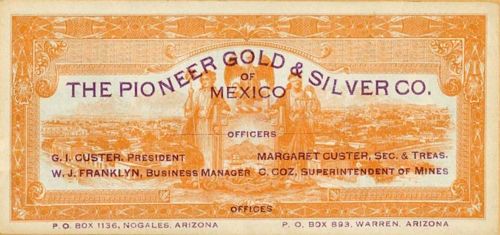Riveros’ definitive issue
On 20 November 1914 General Riveros declared himself a Villista and left Culiacán to establish his government in San Blas.
Riveros’ first currency decree, núm. 3, on 13 July 1913, had authorised a provisional issue of currency until the state passed a law creating a definitive issue. A month later, Riveros’ decree núm. 8 proposed a new issue of $1,000,000 to replace the original notes, which would be more banknote-like in appearance and carry a portrait of Francisco Madero. However, Riveros then had other more pressing problems.
Finally, in January 1915 Riveros wrote to the American Bank Note Company, New York for a quote to replace his provisional issues with a definitive issue (as Maytorena was doing in Sonora). The ABNC replied with quotations for 1,225,000 notes in five lower denominations and 87,000 notes in three higher denominations, but no other correspondence is on fileABNC, . On 22 February 1915, in decree núm. 1, Riveros had revised the quantities:
| Series | Total value |
||
| 25c | A-J | 400,000 | $ 100,000 |
| 50c | A-J | 400,000 | 200,000 |
| $1 | A-J | 400,000 | 400,000 |
| $5 | A-J | 80,000 | 400,000 |
| $10 | A-J | 90,000 | 900,000 |
| $20 | A-J | 75,000 | 1,500,000 |
| $50 | A-J | 20,000 | 1,000,000 |
| $100 | A-J | 5,000 | 500,000 |
| $5,000,000 |
The signatures of the governor, Riveros, and Secretario General, José G. Heredia, were to appear in facsimile on all values and the signatures of the Tesorero General, Matías Ayala, and Interventor, Ignacio Bermúdez, in facsimile on the three lower values and handwritten on the $5 to $100 (in fact when Riveros finally got his notes printed by a different U.S, company, they were printed in error on the three higher values).
|
When Villa broke with Carranza Riveros supported the former, With the Villistas being pursued by forced under Coronel Ignacio Gurrola, he had to flee, leaving behind typewriters, telephones, $112,000 of his own issue, cars, horses etc. In Chihuahua he fell out with Villa who ordered his execution, though the assassins killed his brother Jesús by mistake. He later returned to Sinaloa and devoted himself to agriculture. He died on his hacienda La Providencia on 5 May 1945. |
 |
|
José G. Heredia was born in Llano Grande, Sinaloa, in 1886. As well as serving as Secretario General de Gobierno and a federal Senator, he was a distinguished historian, writing Apuntes para la historia de la guerra de Independencia en el Estado de Sinaloa. He died in 1962. |
 |
| Matías Ayala was a student activistBoth José G. Heredía and Matías Ayala represented the Colegio Rosales, of Sinaloa, at the Congreso Nacional de Estudiantes in September 1910 (El Tiempo, 9 August 1910), one of the organisers for Diego Redo’s candidature in 1909La Iberia, Año IV, Núm. 943, 13 July 1909 and then secretary to Felipe Riveros during his governorship. In early 1913 four men from Culiacán, including Matías Ayala and Ignacio Bermúdez, were accused of fomenting rebellion, arrested by the military authorities and sentenced to enlistment in the army. On 27 June they were transferred to Mexico City where they sought an amparo (injunction) and a deputation of Sinaloan students appealed to the Ministro de Gobernación on their behalfEl Imparcial, 29 June 1913; The Mexican Herald, 1 July 1913. Ayala and Gregorio Cuevas were freed from prison on condition that they did not leave the city, but in November fled back to Sinaloa to join the rebellionThe Mexican Herald, 19 November 1913. |  |
|
Ignacio Bermúdez In early 1913 four men from Culiacán, including Ignacio Bermúdez and Matías Ayala, were accused of fomenting rebellion, arrested by the military authorities and sentenced to enlistment in the army. On 27 June they were transferred to Mexico City where they sought an amparo (injunction) and a deputation of Sinaloan students appealed to the Ministro de Gobernación on their behalfEl Imparcial, 29 June 1913; The Mexican Herald, 1 July 1913. |
 |
The face had the images of Benito Juárez and Francisco Madero, and the reverse an allegory of Justice and Liberty, crowned by the national seal with a view of Culiacán on the left and of Mazatlán on the right. A million pesos of this issue were to be used to redeem the provisional notes of decrees 3, 11, 14 and 17.
Riveros had these notes printed by Britton & Rey, a well-established lithography firm located in San Francisco, California, probably because of cost and a quicker delivery though Britton & Rey had produced a prodigious body of early California town views and so were well-suited to engrave panoramas of Culiacán and Mazatlán. The contracts were placed on 30 January and 1 February 1915. The $5 and $10 notes were printed first (with the Tesorero and Interventor signatures blank); the low values next, and the high values last. These $20, $50 and $100 notes were shipped on 3 July 1915letter Britton & Rey to Riveros, Culiacán, 2 July 1915 but as the printers had mistakenly printed them with four facsimile signatures they were not acceptedletter Riveros to Britton and Rey, 29 July 1915 (lot 26420. Heritage Auctions, 7 January 1915).
25 centavos

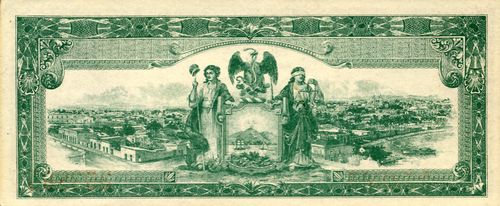
| Series | from | to | total number |
total value |
|
| A | 101 | 40100 | 40,000 | $ 10,000 | with Tesorería stamp |
| B | 40101 | 80100 | 40,000 | 10,000 | |
| C | 80101 | 120100 | 40,000 | 10,000 | |
| D | 120101 | 160100 | 40,000 | 10,000 | |
| E | 160101 | 200100 | 40,000 | 10,000 | |
| F | 200101 | 240100 | 40,000 | 10,000 | unstamped |
| G | 240101 | 280100 | 40,000 | 10,000 | |
| H | 280101 | 320100 | 40,000 | 10,000 | |
| I | 320101 | 360100 | 40,000 | 10,000 | |
| J | 360101 | 400100 | 40,000 | 10,000 |
50 centavos
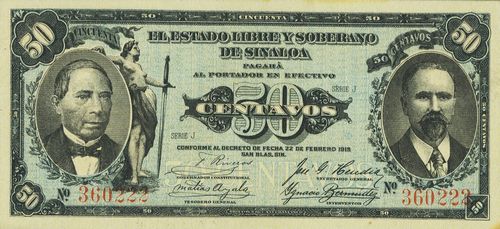
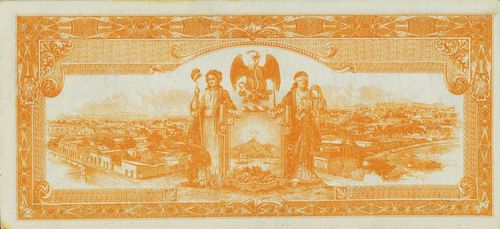
| Series | from | to | total number |
total value |
|
| A | 101 | 40100 | 40,000 | 20,000 | with Tesorería stamp |
| B | 40101 | 80100 | 40,000 | 20,000 | |
| C | 80101 | 120100 | 40,000 | 20,000 | |
| D | 120101 | 160100 | 40,000 | 20,000 | unstamped |
| E | 160101 | 200100 | 40,000 | 20,000 | |
| F | 200101 | 240100 | 40,000 | 20,000 | |
| G | 240101 | 280100 | 40,000 | 20,000 | |
| H | 280101 | 320100 | 40,000 | 20,000 | |
| I | 320101 | 360100 | 40,000 | 20,000 | |
| J | 360101 | 400100 | 40,000 | 20,000 |
One peso
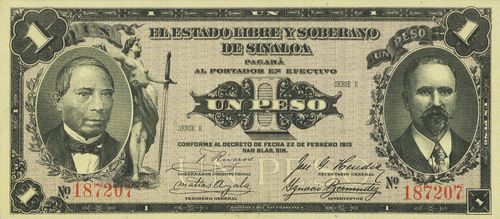

| Series | from | to | total number |
total value |
|
| A | 1001 | 41000 | 40,000 | 40,000 | with Tesorería stamp |
| B | 41001 | 81000 | 40,000 | 40,000 | |
| C | 81001 | 40,000 | 40,000 | ||
| 121000 | 40,000 | 40,000 | unstamped |
||
| D | 121001 | 161000 | 40,000 | 40,000 | |
| E | 161001 | 201000 | 40,000 | 40,000 | unstamped but includes number 160914CNBanxico #6125 |
| F | 201001 | 241000 | 40,000 | 40,000 | unstamped |
| G | 241001 | 281000 | 40,000 | 40,000 | |
| H | 281001 | 321000 | 40,000 | 40,000 | |
| I | 321001 | 361000 | 40,000 | 40,000 | |
| J | 361000 | 401000 | 40,000 | 40,000 |
Five pesos
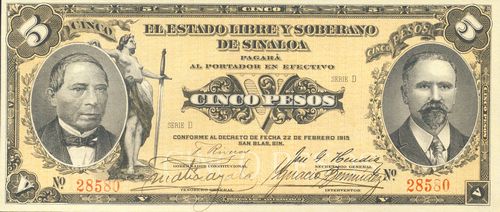
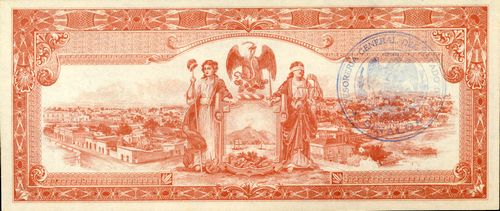
| Series | from | to | total number |
total value |
|
| A | 1001 | 9000 | 8,000 | 40,000 | with Tesorería stamp and two hand signatures |
| B | 9001 | 17000 | 8,000 | 40,000 | |
| C | 17001 | 25000 | 8,000 | 40,000 | |
| D | 25001 | 33000 | 8,000 | 40,000 | |
| E | 33001 | 41000 | 8,000 | 40,000 | |
| F | 41001 | 40,000 | unstamped includes number 44497CNBanxico #6128 to 44500CNBanxico #6130 |
||
| 49000 | 8,000 | with Tesorería stamp and two hand signatures includes numbers 47241 to 47619CNBanxico #6134 |
|||
| G | 49001 | 57000 | 8,000 | 40,000 | unstamped |
| H | 57001 | 65000 | 8,000 | 40,000 | |
| I | 65001 | 73000 | 8,000 | 40,000 | |
| J | 73001 | 81000 | 8,000 | 40,000 |
Ten pesos
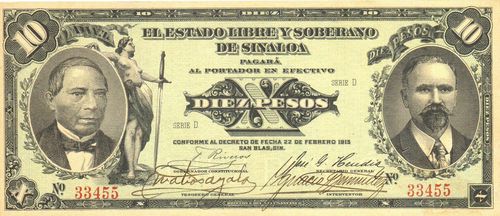
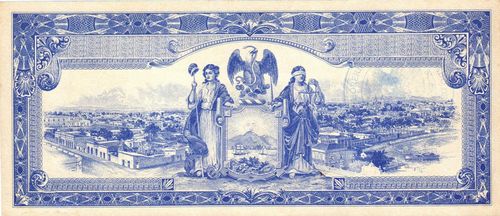
| Series | from | to | total number |
total value |
|
| A | 1001 | 10000 | 9,000 | 90,000 | with Tesorería stamp and two hand signatures |
| B | 10001 | 19000 | 9,000 | 90,000 | |
| C | 19001 | 28000 | 9,000 | 90,000 | |
| D | 28001 | 37000 | 9,000 | 90,000 | |
| E | 37001 | 46000 | 9,000 | 90,000 | |
| F | 46001 | 55000 | 9,000 | 90,000 | unstamped |
| G | 55001 | 64000 | 9,000 | 90,000 | |
| H | 64001 | 73000 | 9,000 | 90,000 | |
| I | 73001 | 82000 | 9,000 | 90,000 | |
| J | 82001 | 91000 | 9,000 | 90,000 |
Twenty pesos
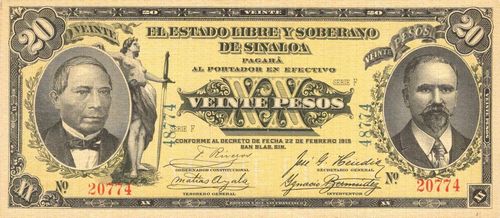

| Series | from | to | total number |
total value |
|
| A | 10000 | 17500 | 7,500 | 150,000 | unstamped red numbers are sequential |
| B | 17501 | 25000 | 7,500 | 150,000 | |
| C | 25001 | 32500 | 7,500 | 150,000 | |
| D | 32501 | 40000 | 7,500 | 150,000 | |
| E | 40001 | 47500 | 7,500 | 150,000 | |
| F | 47501 | 55000 | 7,500 | 150,000 | unstamped blue numbers are sequential |
| G | 55001 | 62500 | 7,500 | 150,000 | |
| H | 62501 | 70000 | 7,500 | 150,000 | |
| I | 70001 | 77500 | 7,500 | 150,000 | |
| J | 77501 | 85000 | 7,500 | 150,000 |
Fifty pesos
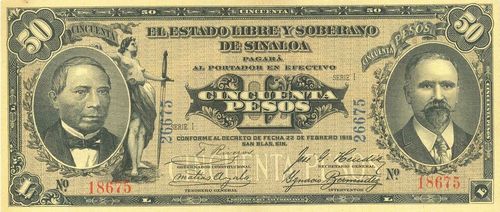
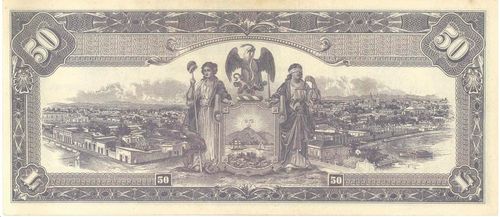
| Series | from | to | total number |
total value |
|
| A | 10001 | 12000 | 2,000 | 100,000 | unstamped red numbers are sequential |
| B | 12001 | 14000 | 2,000 | 100,000 | |
| 14001 | 16000 | 2,000 | 100,000 | ||
| D | 16001 | 18000 | 2,000 | 100,000 | |
| E | 18001 | 20000 | 2,000 | 100,000 | |
| F | 20001 | 22000 | 2,000 | 100,000 | unstamped blue numbers are sequential |
| G | 22001 | 24000 | 2,000 | 100,000 | |
| H | 24001 | 26000 | 2,000 | 100,000 | |
| I | 26001 | 28000 | 2,000 | 100,000 | |
| J | 28001 | 30000 | 2,000 |
One hundred pesos
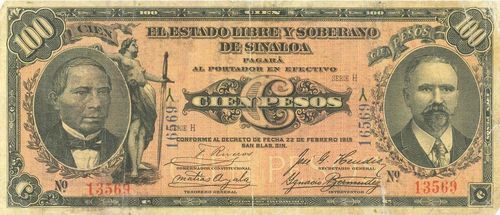
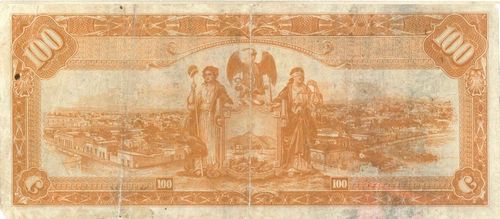
| Series | from | to | total number |
total value |
||
| $100 | A | 10001 | 10500 | 500 | 50,000 | unstamped red numbers are sequential |
| B | 10501 | 11000 | 500 | 50,000 | ||
| C | 11001 | 11500 | 500 | 50,000 | ||
| D | 11501 | 12000 | 500 | 50,000 | ||
| E | 12001 | 12500 | 500 | 50,000 | ||
| F | 12501 | 13000 | 500 | 50,000 | ||
| G | 13001 | 13500 | 500 | 50,000 | ||
| H | 13501 | 14000 | 500 | 50,000 | ||
| I | 14001 | 14500 | 500 | 50,000 | ||
| J | 14501 | 15000 | 500 | 50,000 | ||
| 1,070,000 | $5,000,000 |
Security features
There were five security features on the $5 and $10 valuesletter Britton & Rey to Riveros, 12 March 1915:
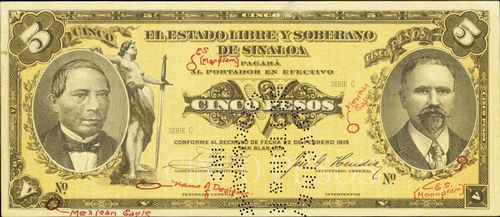
A $5 note marked up with the security devices
| At the foot of the woman is the name of the designer, X. Kraemer. |  |
| In the lower left corner there is an image of the Mexican eagle. |  |
| This image is repeated at the left side of Madero’s portrait, as part of the tint plate | 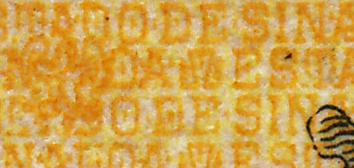 |
| In the lower right corner, in the wreath bordering Madero’s portrait, there is a small monogram“E.S.”(for Estado de Sinaloa). |  |
| This monogram is repeated over the word “Al” in the phrase “AL PORTADOR EN EFECTIVO”, as part of the tint plate. | 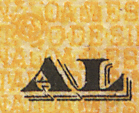 |
For the higher values the printers utilized a trick copied from American notes, namely two sets of serial numbers, one of which is a fictitious control. On the $20 and $50 notes on series A to E the red numbers in the two lower corners were the consecutive numbers and the blue numbers in the centre were the control whilst on series F to J the red numbers were fictitious and the blue numbers authentic. For the $100 notes the red numbers were authentic and the blue fictitious, and a green inverted Y was added on top of the blue numbers as an additional security measureletter Britton & Rey to Riveros, Culiacán, 2 July 1915.
We can presume that note with a 'TESORERIA GENERAL DEL ESTADO - SINALOA' stamp on the reverse or (for higher values) two additional hand signatures were issued (or intended to be issued) whilst the rest were remaindered. So the $20, $50 and $100 values were not issued because they were wrongly printed.
For notes with a typewritten or handwritten legend on back, or a Brigada Juárez resello, see Luis Herrera.
A remainder rather neatly used as a business card or flyer
Decree núm. 2
Because of the pressing need for more 5c and 10c notes on 15 April Riveros also authorised an issue of $40,000 of the former and $60,000 of the latter, both serie A. Again, the decree specified the design of the notes. They were to be of forced acceptance up to $10 in a single payment.
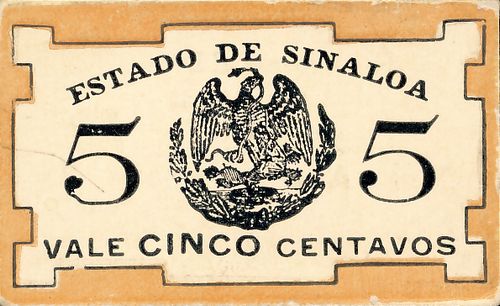
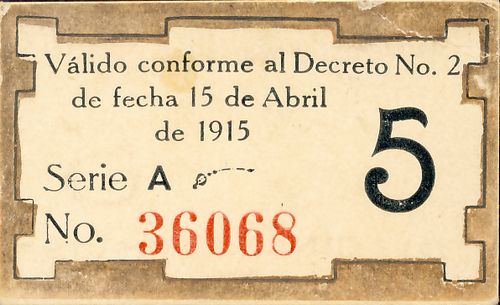
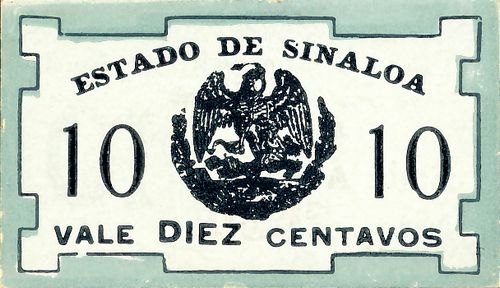
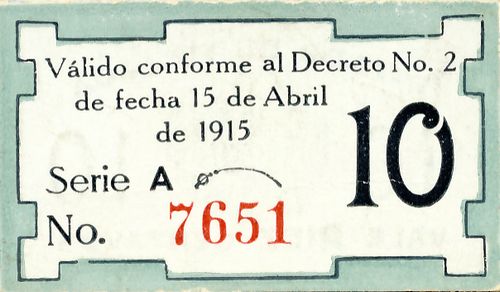
| series | from | to | total number |
total value |
||
| 5c | A | includes number 36068 | ||||
| 10c | A | includes numbers 7651 to 13566 |

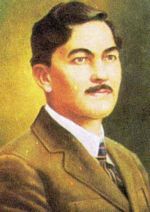 Felipe Riveros Pérez was born in Mocorito, Sinaloa on 5 February 1880. He was president of the Club Antireeleccionista in Angostura in 1910, being a personal friend of Francisco Madero, and later rose in arms, rising to the rank of general. On 26 March 1912, when Governor José Rentería was forced to flee, Riveros was named interim governor and then won the election for the four-year term beginning 27 September 1912. In February 1913 he at first acknowledged Huerta’s usurpation but Huerta had him arrested and taken to Mexico City. He was tried for treason but acquitted and fled back to Sinaloa, where the rebels established themselves at San Blas. On 5 July Carranza recognized Riveros as governor of Sinaloa (though it was not legally in his power to do so Carranza was trying to establish himself as Primer Jefe).
Felipe Riveros Pérez was born in Mocorito, Sinaloa on 5 February 1880. He was president of the Club Antireeleccionista in Angostura in 1910, being a personal friend of Francisco Madero, and later rose in arms, rising to the rank of general. On 26 March 1912, when Governor José Rentería was forced to flee, Riveros was named interim governor and then won the election for the four-year term beginning 27 September 1912. In February 1913 he at first acknowledged Huerta’s usurpation but Huerta had him arrested and taken to Mexico City. He was tried for treason but acquitted and fled back to Sinaloa, where the rebels established themselves at San Blas. On 5 July Carranza recognized Riveros as governor of Sinaloa (though it was not legally in his power to do so Carranza was trying to establish himself as Primer Jefe).